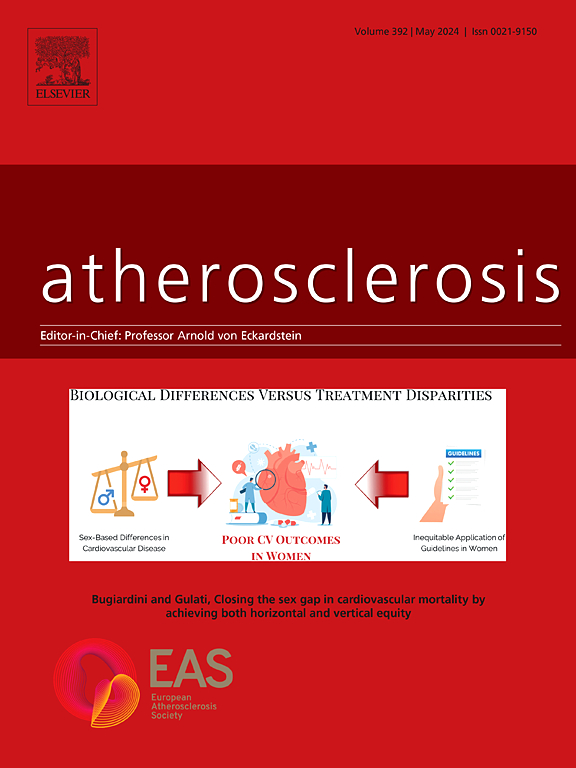外周动脉疾病的低功能与血小板活性增加和心血管事件有关
IF 4.9
2区 医学
Q1 CARDIAC & CARDIOVASCULAR SYSTEMS
引用次数: 0
摘要
背景和目的慢性功能障碍是心血管(CV)事件的独立危险因素。有规律的体育活动可以通过抑制炎症和降低血小板活性来降低心血管风险。我们的目的是研究外周动脉疾病(PAD)患者接受下肢血运重化术(LER)时,由杜克活动状态指数(DASI)量化的功能容量与血小板活性和主要不良心血管和肢体事件(MACLE)的关系。方法对男性和女性LER前分离标本进行轻微传播聚集和血小板RNAseq检测。使用DASI评估功能能力。在LER术后1、6、12和每6个月进行前瞻性随访。将受试者按DASI分数分成五分位数,并使用log-rank检验计算MACLE的发生率。采用最小二乘法拟合线性回归进行中介分析,检验DASI是否通过血小板聚集对MACLE产生影响。结果281例患者完成了DASI问卷,得分范围为0.0 ~ 50.2(底位数为0.0 ~ 9.95)。平均年龄74.4±10.9岁,女性32.4%。在中位随访19个月期间,163名(58.0%)参与者经历了MACLE。在对人口统计学和CV危险因素进行校正后,最低DASI分位数的个体比其他分位数的参与者经历了更多的MACLE。DASI和MACLE之间的关联在按年龄、性别、体重指数、抗血小板治疗和临床合并症分层的多个亚组中是一致的。中介分析表明,在DASI底部,较高的血小板对肾上腺素的聚集介导了24.7%[5.0%,103%]的MACLE风险增加。血小板mRNA在最久坐的个体中显示炎症通路上调(DASI指数最低)。结论PAD合并低功能容量患者血小板活性增高,MACLE发生率高。我们的数据表明,血小板聚集升高介导了四分之一的低功能能力患者接受LER的MACLE风险。我们的研究结果支持一种潜在的血小板介导机制,可以改善与定期体育活动相关的心血管结果。本文章由计算机程序翻译,如有差异,请以英文原文为准。

Low functional capacity in peripheral artery disease is associated with increased platelet activity and cardiovascular events
Background and aims
Low functional capacity is an independent risk factor for cardiovascular (CV) events. Regular physical activity may reduce CV risk through suppression of inflammation and reduced platelet activity. We aimed to investigate the association of functional capacity quantified by the validated Duke Activity Status Index (DASI) with platelet activity and incident major adverse CV and limb events (MACLE) in individuals with peripheral artery disease (PAD) undergoing lower extremity revascularization (LER).
Methods
Light transmission aggregometry and platelet RNAseq were performed on specimens isolated from men and women prior to LER. Functional capacity was assessed using DASI. Prospective follow-up occurred at 1, 6, 12, and every 6 months following the LER. Subjects were separated into tertiles of DASI scores and incidence rates for MACLE were calculated using log-rank tests. Mediation analysis using linear regression fit with least squares was performed to test whether DASI exerted its effect on MACLE via platelet aggregation.
Results
281 patients completed the DASI questionnaire with scores ranging from 0.0 to 50.2 (bottom tertile: 0.0–9.95). Mean age was 74.4 ± 10.9 years and 32.4 % were female.
During a median follow-up of 19 months, 163 (58.0 %) participants experienced a MACLE. After correction for demographics and CV risk factors, individuals in the lowest DASI tertile experienced significantly more MACLE than participants in other tertiles. The association between DASI and MACLE was consistent across multiple subgroups stratified by age, sex, body mass index, antiplatelet therapy, and clinical comorbidities. Mediation analyses suggested higher platelet aggregation to epinephrine in the bottom DASI tertile mediated 24.7 % [5.0 %, 103 %] of increased MACLE risk. Platelet mRNA demonstrated upregulation of inflammation pathways in the most sedentary individuals (lowest DASI tertile).
Conclusions
Patients with PAD and low functional capacity have increased platelet activity and high incidence of MACLE. Our data suggest that elevated platelet aggregation mediates one-quarter of the MACLE risk in persons with low functional capacity undergoing LER. Our findings support a potential platelet-mediated mechanism for improved CV outcomes associated with regular physical activity.
求助全文
通过发布文献求助,成功后即可免费获取论文全文。
去求助
来源期刊

Atherosclerosis
医学-外周血管病
CiteScore
9.80
自引率
3.80%
发文量
1269
审稿时长
36 days
期刊介绍:
Atherosclerosis has an open access mirror journal Atherosclerosis: X, sharing the same aims and scope, editorial team, submission system and rigorous peer review.
Atherosclerosis brings together, from all sources, papers concerned with investigation on atherosclerosis, its risk factors and clinical manifestations. Atherosclerosis covers basic and translational, clinical and population research approaches to arterial and vascular biology and disease, as well as their risk factors including: disturbances of lipid and lipoprotein metabolism, diabetes and hypertension, thrombosis, and inflammation. The Editors are interested in original or review papers dealing with the pathogenesis, environmental, genetic and epigenetic basis, diagnosis or treatment of atherosclerosis and related diseases as well as their risk factors.
 求助内容:
求助内容: 应助结果提醒方式:
应助结果提醒方式:


